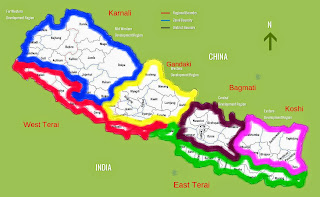I am pretty happy with the map I drew a few days back.
6 Geographic States With Geographic Names

The next question obviously is, how do you constitute the national parliament.
The two Terai states would end up with something like 55% of the population and so should get 55% of the MPs.
How many MPs total? If a large country like India has about 500, a small country like Nepal should be able to do with 200. So, say, 205 is the Lower House, and 100 in the Upper House.
Once you figure out which district gets how many MPs, then there should be reservations. 10% of the constituencies should be reserved for Dalits. As in, only Dalit candidates may contest. These should be the 22 constituencies with the largest shares of Dalit populations. Eight of these 22 should be reserved for Dalit women.
Every third constituency should be reserved for women. 20% of these for Dalit women, 30% for Madhesi women, 30% for Janajati women.
First past the post for the Lower House.
For the 100 seats in the Upper House, it is all proportional. So a party that gets 30% of the votes gets 30% of the seats, and so on. The list has to be submitted beforehand. As in, you can not change the list ex post facto. And the list should be inclusive of the DaMaJaMa. As in, one third women, 10% Dalits, and so on. One third women meaning every third name on the list is a woman.
205 + 100 = 305.
This would be the national parliament. It could be made that the entire parliament elects the Prime Minister, and not just the Lower House.
Every elected leader in the country at local, state and national level will form a pool. That pool will elect a president who would be the constitutional head and the Commander In Chief of the Nepal Army.
6 Geographic States With Geographic Names

The next question obviously is, how do you constitute the national parliament.
The two Terai states would end up with something like 55% of the population and so should get 55% of the MPs.
How many MPs total? If a large country like India has about 500, a small country like Nepal should be able to do with 200. So, say, 205 is the Lower House, and 100 in the Upper House.
Once you figure out which district gets how many MPs, then there should be reservations. 10% of the constituencies should be reserved for Dalits. As in, only Dalit candidates may contest. These should be the 22 constituencies with the largest shares of Dalit populations. Eight of these 22 should be reserved for Dalit women.
Every third constituency should be reserved for women. 20% of these for Dalit women, 30% for Madhesi women, 30% for Janajati women.
First past the post for the Lower House.
For the 100 seats in the Upper House, it is all proportional. So a party that gets 30% of the votes gets 30% of the seats, and so on. The list has to be submitted beforehand. As in, you can not change the list ex post facto. And the list should be inclusive of the DaMaJaMa. As in, one third women, 10% Dalits, and so on. One third women meaning every third name on the list is a woman.
205 + 100 = 305.
This would be the national parliament. It could be made that the entire parliament elects the Prime Minister, and not just the Lower House.
Every elected leader in the country at local, state and national level will form a pool. That pool will elect a president who would be the constitutional head and the Commander In Chief of the Nepal Army.

